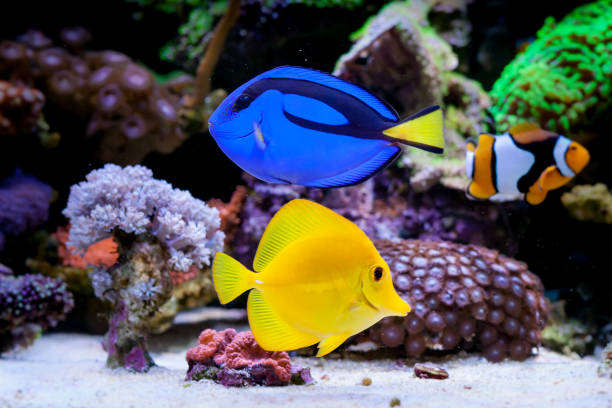
Setting up a fish tank is an exciting venture for both beginners and experienced aquarium enthusiasts. However, before introducing any fish to their new aquatic home, it is crucial to establish a stable and healthy environment for them. This process is known as cycling a fish tank. Cycling is essential because it establishes beneficial bacteria that help break down toxic ammonia and nitrites, ensuring the well-being of your aquatic pets. In this comprehensive guide, we will walk you through the step-by-step process of cycling a fish tank to create a thriving ecosystem for your fish.
Step 1: Gather Essential Equipment
Before you start cycling your fish tank, ensure you have all the necessary equipment and supplies ready. Here’s what you’ll need:
- Fish Tank: Choose an appropriate-sized tank based on the species and number of fish you plan to keep. Ensure it is clean and free of any chemicals or residues.
- Substrate: Gravel or sand for the tank’s bottom. Rinse it thoroughly to remove dust and debris.
- Water Conditioner: A de-chlorinator to remove chlorine and other harmful chemicals from tap water.
- Aquarium Filter: A reliable filter to promote water circulation and house beneficial bacteria.
- Heater: If you plan to keep tropical fish, a heater with a thermostat is essential to maintain a consistent temperature.
- Test Kits: Freshwater or Saltwater, Invest in a quality water testing kit to monitor ammonia, nitrite, nitrate, and pH levels.
- Fish Food: You will need a source of ammonia to kick-start the nitrogen cycle. Fish food will serve this purpose.
- Decorations and Plants: Optional, but they provide hiding spots for fish and enhance the tank’s aesthetic.
Step 2: Setting up the Tank

- Select a Location: Place your fish tank in a stable location away from direct sunlight and temperature fluctuations.
- Rinse Substrate and Decorations: Rinse the substrate and decorations thoroughly to remove dust and debris. Arrange them as desired in the tank.
- Install Equipment: Set up the heater, filter, and any additional equipment according to the manufacturer’s instructions.
- Fill with Water: Fill the tank with dechlorinated water. Use a bowl or plate to disperse the water gently to prevent substrate disturbance.
- Add Water Conditioner: Add the recommended amount of water conditioner to the tank to neutralize chlorine and chloramines.
Step 3: Start the Nitrogen Cycle

- Add Ammonia Source: To kick-start the nitrogen cycle, add a small amount of fish food to the tank. As it decomposes, it will release ammonia. Alternatively, you can use pure ammonia (without additives) with a dropper to achieve controlled levels.
- Add Beneficial Bacteria: Introduce beneficial bacteria to the tank to help establish the nitrogen cycle more quickly. You can do this by:
- Using a commercial bacterial starter product designed for aquariums. Follow the manufacturer’s instructions for dosing.
- Transferring filter media, decorations, or substrate from an established, healthy aquarium. These items often carry beneficial bacteria.
- Seeding the tank with bacteria from an established aquarium by adding a small amount of water from the established tank to the new tank.
- Monitor Ammonia Levels: Use a water testing kit to monitor ammonia levels regularly. During the cycling process, ammonia will spike, which is a normal part of the cycle.
- Beneficial Bacteria Growth: Over time, beneficial bacteria will develop in the filter media, substrate, and throughout the tank. These bacteria convert ammonia into nitrites and then nitrites into nitrates, which are less harmful to fish.
- Monitor Nitrite and Nitrate Levels: As the beneficial bacteria establish themselves, you will observe a decrease in ammonia levels and an increase in nitrite levels. Once nitrites begin to rise, the second stage of the nitrogen cycle is underway. Continue monitoring until nitrites drop and nitrates rise.
Step 4: Testing and Maintenance
- Regular Water Testing: Throughout the cycling process, perform regular water tests to track ammonia, nitrite, nitrate, and pH levels. This will help you understand the progress of the nitrogen cycle.
- Partial Water Changes: If ammonia or nitrite levels become dangerously high, perform partial water changes (about 25%) using dechlorinated water. This will dilute the toxins while maintaining the bacteria’s growth.
Step 5: Complete the Cycle
- Patience: Cycling a fish tank can take anywhere from a few weeks to a few months. Be patient and avoid adding fish until ammonia and nitrite levels are consistently at zero, and nitrates are present.
- Look For: Ammonia levels to be at Zero, Nitrite to be at Zero, and Nitrates to be present. This means the tank is cycled.
- Add Fish Gradually: Once the tank is cycled, you can start adding fish gradually. Begin with a few hardy species and give the tank time to adjust before adding more.
Conclusion
Cycling a fish tank is a crucial step in creating a healthy and stable aquatic environment for your fish. By following these step-by-step instructions, you can establish a thriving ecosystem that will provide a safe and comfortable home for your aquatic pets. Remember, patience and regular monitoring are key to a successful fish tank cycle. With the right care and attention, your aquarium will become a source of joy and beauty in your home.
ChasingNemo.com is a participant in the Amazon Services LLC Some of the links in our posts are affiliate links. Click Here For Full Disclosure.







